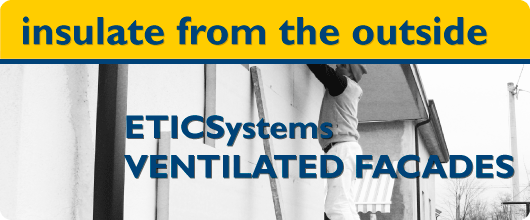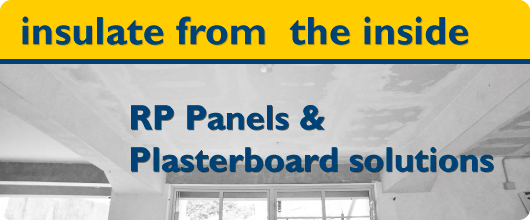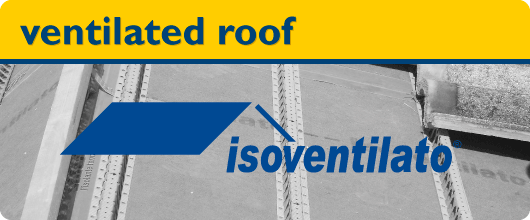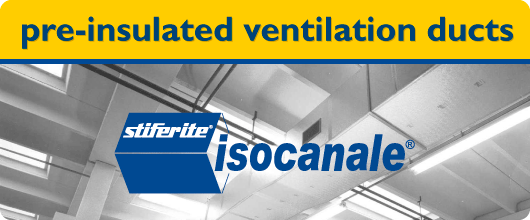PREPARATION OF THE LAYING SURFACE
If the laying surface, either horizontal or vertical is noticeably unlevelled, make the necessary levelling adjustments.
Make the necessary repairs and/or adjustments to a roof surface, so as to guarantee its' uniformity and perfect seal.
If the roof slab surface is scuffing or peeling, apply a coat of primer.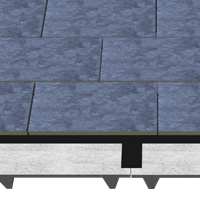 Roof and floor slabs
Roof and floor slabs
In the case of panels with rabbetted (male-female) joints, see figure, it is suggested that the longer side of the panel is laid in parallel to the edge stop beam and transverse to the line of the roof slope.
If the roof is waterproofed with a mantle in-view, it is recommended to try and avoid that the joining line between panels coincide with eventual discontinuity of the laying surface. (i.e. joints between tiles or pre-fabricated roof slabs).
The membranes are always laid transverse to the direction of the panels and normally longitudinally to the direction of the roof slop. The panels, therefore are laid transversely to the direction of the roof slope.
It is also possible to lay the panels in a braid like configuration, which would then allow the membrane to be laid in both directions (see sketch).
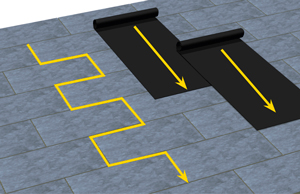
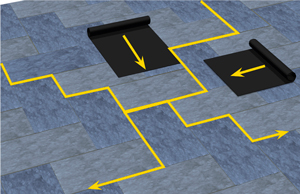
INSTALLATION
In roof applications, especially under waterproofing membranes in-view, it is very important that the insulation is properly fixed to the structure. In the case of waterproofing systems in-view, the adhesion between panels, vapour barrier, and the structure must always be greater then or equal to the adhesion between the panel and the waterproofing membrane.
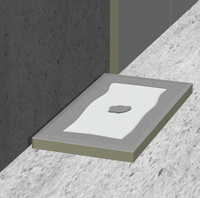 Mortar and Adhesives
Mortar and AdhesivesWhen using mortar or adhesive cement, it is suggested that a continuous bead is spread around the parameter of the panel and one or two spots of mortar/adhesive at the centre.
To avoid an excess of mortar between each panel, it is recommended that a thinner layer is spread along the border and thicker toward the centre.
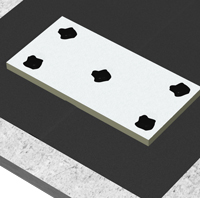 Bitumen Adhesive applied "cold"
Bitumen Adhesive applied "cold"The adhesive may be applied in different points on the panel.
For standard panels in 600 x 1200 mm, we suggest one spot on each corner (at least 50 mm from the edge) plus a spot in the centre.
The perimeter proportions would be increased in the case of panels of larger dimensions, and with two spots in the centre.
Immediately after applying the adhesive, the panel is pressed firmly to the surface to be insulated.
Solvents that may be present in the bitumen adhesive, will not affect the polyiso foam used in Stiferite's panels, therefore it is not necessary to wait for a period of evaporation before installing the panels.
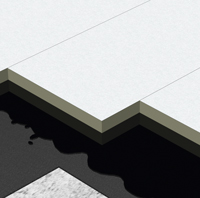 Hot Bitumen
Hot BitumenIn general, 4-6 spots per square meter is required, on all corners and in the centre of the panel. The type of fixing, anchors, screws, self-threading screws, nails, etc..vary based on the type of support.
Consult qualified installers of the entire system for verification of the procedure.
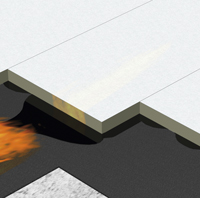 Torched Bitumen
Torched BitumenIn the case of the vapour barrier made of a bitumenous mantle, liquify the bitumen from the top surface using a flame torch and immediately lay down the panel over it. Step down on the panel and press firmly for proper adhesiveness. This method may not guarantee a high level of adhesion in all conditions of applications.
Do not expose or apply the flame directly to the panel. It is important that in the presents of an open flame or heater, the work site is equipped with proper fire safety equipment and that the workers follow proper fire prevention procedures during the installation.
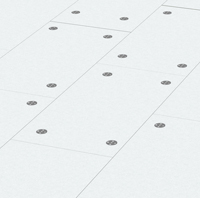 Mechanical Fixing
Mechanical FixingFor roofs, we suggest standard panels in 600 x 1200 mm, four anchoring points one on each corner at least 50 mm from the edge. The perimeter proportions would be increased in the case of panels of larger dimensions, and with one or two in the center.
The type of fixing, anchors, screws, self-threading screws, nails, etc..vary based on the type of support.
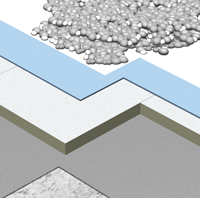 Laid down as is
Laid down as isIn this case, the panels are simply placed down side by side, used in all floor applications and adoptable also to waterproofing systems with synthetic membranes, ballasted roofs with heavy mobile protection (gravel, squares of washed gravel, etc…) or still (flooring).
In these applications the distribution of the ballast or other weighting layers, must be done immediately after the installation of the panels and the waterproofing mantle. Otherwise, to avoid damages caused by the wind, the application must made using the same hardware as those used in mantles in-view.
Sommary products
Pannels:Bonded panels:
Systems:



